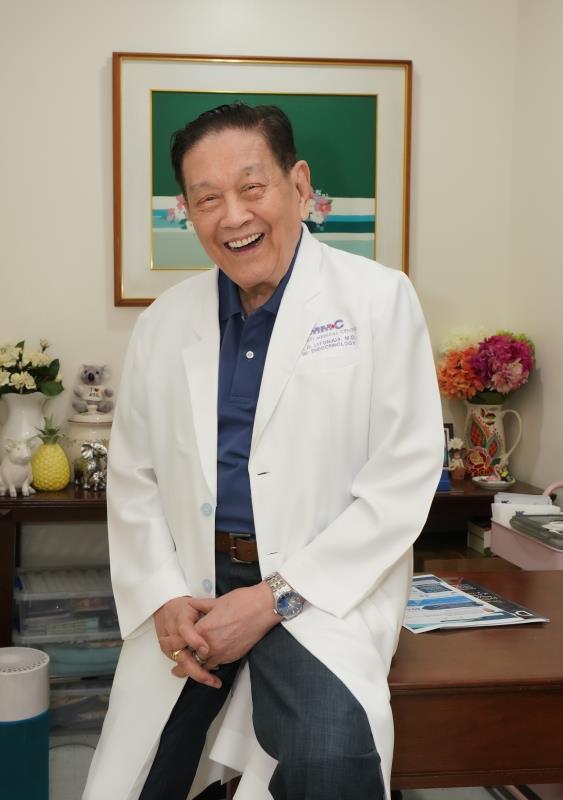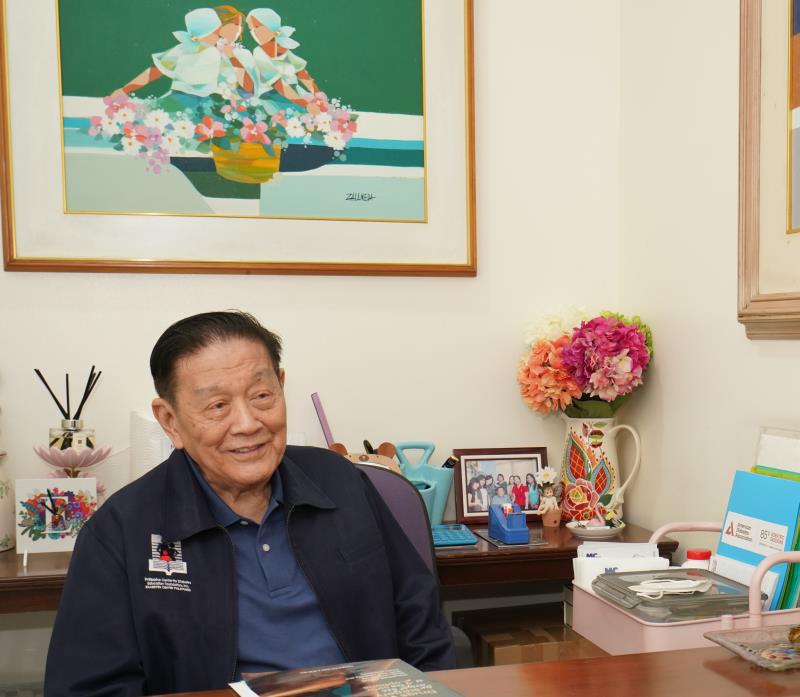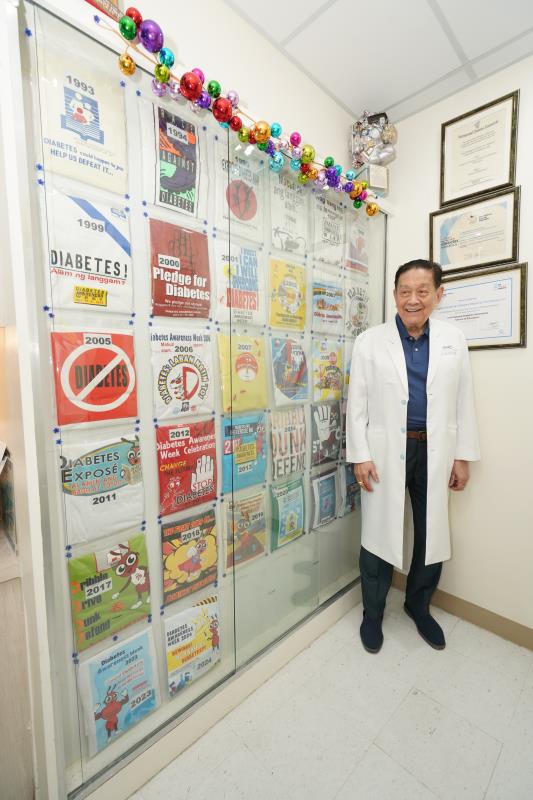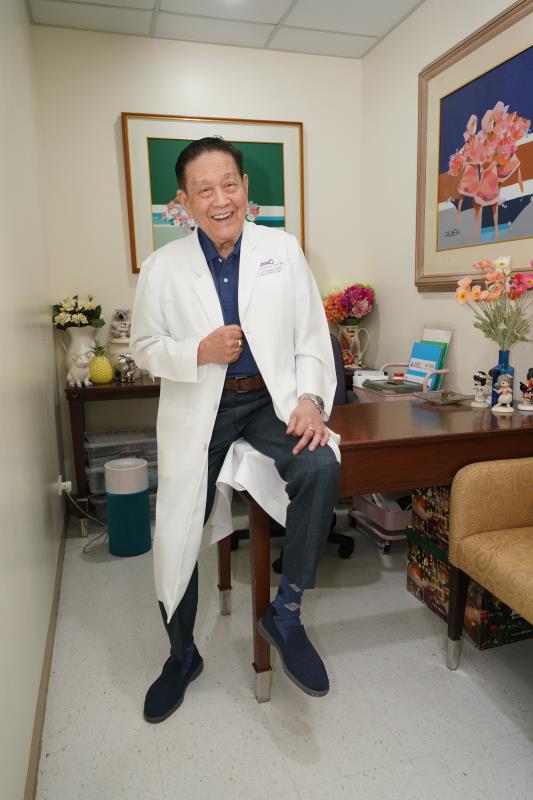Back in the ‘60s, something was bothering a younger Dr Augusto D. Litonjua. Landing back in Manila enlightened by Harvard mentors, he realized there was no networking among endocrinology-leaning local practitioners, much less any organization, for that matter.
"He reminds us of Sir David Attenborough, another nonagenarian who keeps busy. But unlike him, Litonjua, with his headful of black hair combed neatly aft from a low hairline, can easily be mistaken for a young baby boomer."
So, he gathered around like-minded colleagues, and, in 1962, led the creation of the Philippine Society of Endocrinology and Metabolism, serving as its founding president. Nowadays, the society is known as the Philippine College of Endocrinology, Diabetes and Metabolism (PCEDM).
 Dr Litonjua at the Diabetes Center Philippines
Dr Litonjua at the Diabetes Center Philippines
Essentially, the practice of endocrinology was born with PCEDM’s founding. The society’s effect was such that his students and trainees began introducing him pre-lecture as the father of endocrinology. And that is the origin story of his moniker.
Now, even after countless accomplishments, nothing has ever fazed the Professor Emeritus at 94-ish. He might have dialed down on his lectures, but—believe it or not—he is still treating the sick up to this day, juggling clinics in three hospitalsa on a six-day work week. This would seem impossible in our ageist and youth-obsessed society.
But to our surprise, his mind is as sharp as it has ever been, his voice, unwavering, and his observations on precision medicine, keen. He cuts a distinguished, well-poised, smart-looking, smiling, godfatherly figure in a crisp white coat.
He even reminds us of Sir David Attenborough, another nonagenarian who keeps busy. But unlike him, Litonjua, with his headful of black hair combed neatly aft from a low hairline, can easily be mistaken for a young baby boomer—that is, had we not found out his birthday. He will be turning 95 in—you guessed it right—August. But he is not to be confused with another Dr Augusto, his eldest son. “My son’s middle initial is ‘A’,” he would emphasize.
Litonjua recently spoke with MIMS Doctor on May 9, 2025 at the Diabetes Center Philippines, about surviving World War 2 and cancer, founding organizations, explaining his legacy, and still seeing patients on the daily. Below, edited for clarity, are excerpts of the interview (portraits are by Jonathan Ico).
 During the interview
During the interview
Early life, education, training, research, clinics and teaching
What was your childhood like?
I topped our batch at San Juan de Letran’s grade school before World War II. When the war broke out, my baby brother was incessantly crying from the bombing of Intramuros and food was scarce; so, we decided to escape to La Union on my mother’s side, where I then graduated high school valedictorian. In 1951, I went on to finish the two-year Associated Arts with high honors at the University of the Philippines (UP).
When did you decide you wanted to become a doctor?
My mother, who was my grandfather’s drugstore’s pharmacist in Pagbilao, Quezon dreamt of me becoming the first doctor in the family, after a cousin became ill and did not push through with medical school. Also, my grandfather was a cirujano of some sort [Spanish for “surgeon”] during the Spanish times. He could somehow diagnose and treat but he was not a medical doctor.
"While about to
enter college, I told my mother I wanted to take up journalism. She said to the
effect, “Okay if that’s what you want.” It sounded like a yes, but her tone
said otherwise."
Where did you train? Why did you pursue endocrinology? Who were your mentors and role models? Did you teach?
I matriculated at the UP College of Medicine (UPCM), being ranked number two coming in as a freshman, then graduating in 1956. All my fees were waived because my father was in the guerrilla movement.
One of my mentors, our dean at that time, egged me on to train in internal medicine at the UP Philippine General Hospital (UP-PGH), instead of surgery, which was my mother’s liking. In fact, my girlfriend then, now my wife, Dr Mary Peralta Ampil [editor’s note: who is a nonagenarian herself], took up anesthesiology, so we could tag-team in practice, had I become a surgeon.
Then, I instructed physiology at UPCM, again at the dean’s urging, while helping establish UP-PGH Department of Medicine’s radioactive laboratory, their incipient nuclear medicine unit. My initial dip into clinical endocrinology was thyroid diseases, as the lab mainly handled thyroid medicine.
After less than a year of partial residency, non-residential practice, and instructorship, I held dual appointments as a research fellow at Harvardb and MassGen’sc Thyroid Clinic from 1958 to 1960. As an aside, I got married at this time. From MassGen, I opted to work with Boston City Hospital’s Dr Norbert Freinkel, who was known for his research on diabetes in pregnancy.
Then I went back home to the academe and the clinics, working my way up to become the heads of both the Department of Physiology at UPCM and the Department of Medicine’s Section of Endocrinology at UP-PGH. I did a sabbatical for three months as a visiting scientist, holding clinics at the University of Washington’s Harborview Medical Center.
 Dr Litonjua right next to the Diabetes Center’s display cabinet showing the organization’s event t-shirts
Dr Litonjua right next to the Diabetes Center’s display cabinet showing the organization’s event t-shirts
What were the results of your research during your fellowships and sabbatical?
At MassGen, my research dealt with the hydrolysis of thyroglobulin, writing papers on the subject for the Endocrinology and Nature journals. I wanted to see if the enzymes an Australian biochemist isolated from the thyroid could hydrolyze thyroglobulin into T4 and T3. I found out they did not. Thyroglobulin was eventually discovered by another study to be self-hydrolyzing. At Harborview, we discovered that thyroid effects were manifested when some organs of the body converted T4 to T3.
Under Dr Freinkel, I worked on the effects of insulin on fat cells using rat models. On hindsight, my methods involving the Wargburg apparatus, which measures tissue metabolism, were too “macro” to show any meaningful “micro” effects. We also studied lactic formation and other effects of insulin on fat and glucose utilization.
"My research did
help prove that the hydrolysis of thyroglobulin happens inside the vesicles of
the thyroid follicular cells, not outside these cells. Also, the proteolytic
enzymes identified in Australia, being localized in the cytoplasm, are, thus,
not responsible for vesicular hydrolysis."
You authored or co-authored more than 100 research papers and other written works. Which were the most challenging and most memorable studies you did?
It’s more like that the most challenging part had to be ensuring that the primary objectives of my research were observed. But one of my studies did help prove that the hydrolysis of thyroglobulin happens inside the vesicles of the thyroid follicular cells, not outside these cells. Also, the proteolytic enzymes identified in Australia, being localized in the cytoplasm, are not responsible for vesicular hydrolysis.
Why did you shift your career focus from thyroid diseases to diabetes?
It’s not a shift. Endocrinologists commonly treat diabetes and thyroid diseases, as other endocrine diseases are rare. Diabetes is even a global pandemic with complications far greater than those of thyroid diseases.
Which do you prefer between practicing and teaching?
I love both. I would be bored if I were just practicing. Same with teaching.
What’s a memorable experience you had in the clinics?
Rita Moreno, the Oscar, Emmy, Tony and Grammy award–winning Hollywood actress, came over in Manila. Being thyrotoxic, she was referred to me. I did the workup, but she left without paying me. Upon coming back to the country, the first thing she did or so I thought was pay the bill. People made up stories that I kissed her when, in fact, I just shook her hands.
What career would you have picked, had you not gone into medicine?
While about to enter college, I told my mother I wanted to take up journalism. She said to the effect, “Okay if that’s what you want.” It was a yes, but her tone said otherwise. At UPCM, I was the editor-in-chief of the student publication. After postgrad training, I served the same for Acta Medica, UPCM’s scientific journal.
Organizations and awards
Why did you establish the Philippine Center for Diabetes Education Foundation (Diabetes Center Philippines)? What did you accomplish with the Center?
As diabetes awareness plays an important role in the management of diabetes, there was an urgent need to train a team of nurses, nutritionists, and doctors to educate patients and families. The center runs these activities: intensive training for educators, separate learning camps for type 1 diabetics and type 2 diabetic adult couples, the Diabetes Awareness Week, the National Assembly of Diabetes Educators, and finally the Presidential Activities in which we do citations, visitations and a mini awareness drive. As the president, I make sure that we run these activities smoothly, in partnership with civic-minded entities.
Besides establishing the center and PCEDM, you were active in many organizations and institutions. Can you name memorable ones? Did you have non-professional ones?
I have no non-professional ones. I just don’t have the time because aside from academic, administrative, and society commitments, I have been busy with practice.
Right out of my head, some of the things I did was organize Makati Medical Center’s Section of Endocrinology. I was Chief of Medicine and Chief of Endocrinology at the Asian Hospital and Medical Center. I was also the Founding President of the Philippine Association for the Study of Overweight and Obesity (PASOO). I had leadership roles in many national and ASEAN-level societies and associations. You can just look them up in my CV.
I’m looking at a very long list of awards bestowed on you. Which ones are the most important to you?
I have three lifetime awards. Lifetime awards are one way of saying they could no longer give me more awards. The most prestigious one I got was being named the government’s Republic Cultural Heritage Awardee in Medicine in 1964. The most popular award was when Jaycees named me one of the Ten Outstanding Young Men in 1962.
On diabetes
As a frequent resource speaker on diabetes, what memorable lessons have your audience learned from you?
This year, when I lectured at the Philippine College Physicians, many in the audience knew for the first time that the SGLT-2 inhibitors not only have beneficial diabetic, cardiac, and renal effects but also an anti-cancer effect. As for the GLP-1 receptor agonists and their weight loss side effect, we need to be careful, as we only want our patients to lose their fat, not their muscle. It’s important to do resistance exercises to preserve lean body mass.
What is the most common misconception about diabetes?
It’s still that diabetes is curable. While common before, some people still think that once the blood glucose has been lowered, they will now stop taking their meds. While incurable, diabetes is manageable and preventable.
What do you think is the biggest challenge in diabetes care?
Precision medicine. Our greatest challenge now is defining diabetes, because it’s not a homogeneous disease. Type 2 diabetes has many variants, such as insulin-resistant, insulin-deficient, age-related, and obesity-related. Artificial intelligence can help us assess a patient’s diabetes, looking into many things, such as physique, genes, and lifestyle.
What can the government specifically do to improve healthcare and help upend the diabetes epidemic?
There was a commission on diabetes before that failed. It was all meetings and no action. It doesn’t hurt to have a benevolent dictator who can impose a healthy diet on people, incentivize the same, and tax all the unhealthy food.
The present and future
What keeps you busy nowadays aside from your practice?
Right now, I’m also the President Emeritus and Adviser of the Philippine Chapter of the American Association of Clinical Endocrinologists. I’m part of the Council of Elders of PCP. I’m no longer involved with PCEDM, but they just asked me to deliver a lecture of distinction, in my honor.
 Dr Litonjua smiling
Dr Litonjua smiling
What are some of your hobbies and interests outside of medicine? What are your favorite books, movies, or music?
I don’t have hobbies right now. I used to play the violin and piano. I also enjoyed bowling and pelota. My wife was very good at pelota, but with the ball flying so fast, accidents were common. Right now, I have several books by old philosophers lined up for reading once I retire. The problem is I haven’t retired yet. I also watch mostly detective movies on Netflix and listen to romantic songs. I have a collection of Josh Groban’s songs. My favorite now is Lara’s Theme from the Dr Zivago movie.
Did your children follow your footsteps in their careers?
We have four sons: two doctors, one architect, and one dentist. My eldest is a professor and the Chief of the Division of Pediatric Pulmonary Medicine at the University of Rochester Medical Center. He is more successful than I am.
What is your definition of success?
We are only here for a period and are meant to do something in this world. I had some goals I wanted to achieve, and if one has achieved 80 to 90 percent of whatever one wanted to achieve, I would already call it a success.
What important pieces of advice can you give to young doctors?
Doctors are here to help alleviate the ills of humanity. That’s the first concern. Of course, we also need to earn a living and survive. We cannot treat patients and not charge a fee.
What are your aspirations for the immediate future?
I’m wondering who will succeed me at Diabetes Center Philippines This is my longest residency in an organization. In contrast, I have no worries of the doctors who have succeeded me at PASOO and PCEDM, as the present crop of endocrinologists are competent and better trained than I was.
We’ve been interviewing for more than an hour. For a 94-year-old, you are engaging. I wonder if you have health concerns and routines right now. What keeps you healthy?
I’m a colon cancer survivor. I have an indolent prostate cancer. I also have heart failure; thirty or so years ago, I suffered from a heart attack. I was a smoker when I was younger, so I also have COPD. Right now, I just eat right and exercise. I take things in stride and keep busy. I keep my weight down, losing 25 pounds. My mother was diabetic and two of my sisters are, but I’m not.
What do you think are your most important legacies?
All the organizations I helped found, but particularly, PCEDM. When I came back in 1961, there was no endocrinology specialty to speak of. Some of my professors were chiding me for pursuing endocrinology. They said diabetes is already being taken care of by IM.
But when we treat diabetic ketoacidosis, many patients die even after we control the blood glucose. The reason for this is we didn’t know potassium was important in the treatment. Patients can die of hypokalemia when they emerge from their acidotic stage.
So, there was a real need for specialists who understand endocrine diseases and are more experienced to treat them. Our founding of PCEDM, a first in the ASEAN region, was key to the existence of endocrinology as a discipline in the country.
That is my most important legacy.
aMakati Medical Center, Asian Hospital and Medical Center, and Manila Doctors Hospital
bHarvard Medical School
cMassachusetts General Hospital